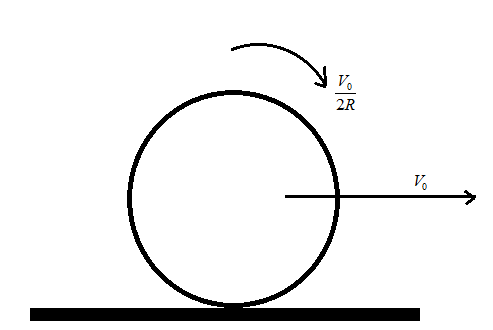Question
Question: Consider the sphere moving on the horizontal plane at some instant it have line velocity \( {V_0} \)...
Consider the sphere moving on the horizontal plane at some instant it have line velocity V0 and angular velocity about center of mass 2RV0 . The translational velocity after the sphere starts pure rolling.

(A) 75V0
(B) 76V0
(C) 43V0
(D) 53V0
Solution
Here, we are supposed to find the velocity of the sphere in translational motion. The sphere has velocity when it is slipping and before the sphere starts rolling. For this we will use the concept of translational and rotational motion.
Complete step by step answer:
here, in the given figure the angular velocity as:
ω0=2RV0
⇒V0=2ω0R
∴V0>ω0R
Due to slipping of the sphere the friction acts in backward direction as shown below:

Now here the mass of the sphere is not given then we have to consider mass as M , f is the friction acting in backward direction and R is the radius of the sphere. The moment of inertia along the center of mass is given by:
ICM=52MR2
Now, for translational motion let V be the translational velocity and it is given by:
V=V0−at …. (Acceleration along the direction of friction force)
⇒V=V0−Mft …. (1) (∵f=Ma)
Now when the sphere starts rolling, the rotational motion and the final angular velocity is given by:
ω=ω0+αt …. (Angular acceleration, forward direction)
⇒RV=2RV0+αt …. (ω=RV,ω0=2RV0) (2)
So, we know that torque of the rotational motion is given by:
τ=Iα
⇒fR=52MR2α …. (Torque is given by the frictional force along the radius)
∴α=2MR5f
Put this value in equation (2) , we get:
⇒RV=2RV0+2MR5ft
⇒V=2V0+2M5ft …. (3)
On equating (1) and (3)
⇒V0−Mft=2V0+2M5ft
On solving this we get
⇒21V0=27Mft
⇒Mft=7V0
Now put this value in equation (1) , we get
⇒V=V0−7V0=76V0
∴V=76V0
Hence, we obtained the translational velocity of the sphere when it starts rolling as 76V0
The correct answer is option B.
Note:
Here, in the given figure we see the sphere is given and the velocity of its center but it has been asked what will be the translational velocity when it starts rolling. For that we considered the slipping motion of the sphere first and then rolling by this we are able to do this problem. Force is acting backward because of forward slipping.
